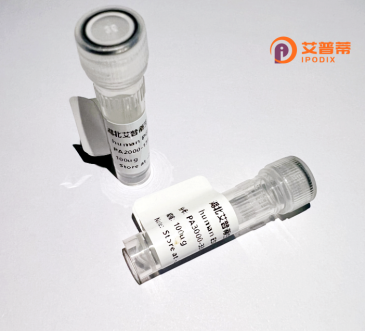
| 纯度 | >90%SDS-PAGE. |
| 种属 | Human |
| 靶点 | RUSC1 |
| Uniprot No | Q9BVN2 |
| 内毒素 | < 0.01EU/μg |
| 表达宿主 | E.coli |
| 表达区间 | 1-433 aa |
| 活性数据 | MAEAQSGTGQLQEQKKGLLIAVSVSVDKIISHFGAARNLVQKAQLGDSRLSPDVGHLVLTTLCPALHALVADGLKPFRKDLITGQRRSSPWSVVEASVKPGSSTRSLGTLYSQVSRLAPLSSSRSRFHAFILGLLNTKQLELWFSSLQEDAGLLSLLYLPTGFFSLARGGCPSLSTELLLLLQPLSVLTFHLDLLFEHHHHLPLGPPQAPAPPGPPPALQQTMQAMLHFGGRLAQSLRGTSKEAASDPSDSPNLPTPGSWWEQLTQASRVYASGGTEGFPLSRWAPGRHGTAAEEGAQERPLPTDEMAPGRGLWLGRLFGVPGGPAENENGALKSRRPSSWLPPTVSVLALVKRGAPPEMPSPQELEASAPRMVQTHRAVRALCDHTAARPDQLSFRRGEVLRVITTVDEDWLRCGRDGMEGLVPVGYTSLVL |
| 分子量 | 73 kDa |
| 蛋白标签 | GST-tag at N-terminal |
| 缓冲液 | PBS, pH7.4, containing 0.01% SKL, 1mM DTT, 5% Trehalose and Proclin300. |
| 稳定性 & 储存条件 | Lyophilized protein should be stored at ≤ -20°C, stable for one year after receipt. Reconstituted protein solution can be stored at 2-8°C for 2-7 days. Aliquots of reconstituted samples are stable at ≤ -20°C for 3 months. |
| 复溶 | Always centrifuge tubes before opening.Do not mix by vortex or pipetting. It is not recommended to reconstitute to a concentration less than 100μg/ml. Dissolve the lyophilized protein in distilled water. Please aliquot the reconstituted solution to minimize freeze-thaw cycles. |
以下是关于重组人RUSC1蛋白的3篇参考文献示例(注:内容为简化示例,建议通过学术数据库核实具体文献):
1. **文献名称**: *RUSC1 modulates neuronal differentiation via regulating axonal transport*
**作者**: Zhang Y, et al.
**摘要**: 研究揭示了RUSC1在神经元分化中的作用,表明其通过调控轴突运输中的囊泡运输蛋白(如KIF5A)影响神经突的生长,缺失RUSC1会导致神经元发育异常。
2. **文献名称**: *RUSC1 interacts with EGFR to promote breast cancer metastasis*
**作者**: Wang L, et al.
**摘要**: 报道RUSC1在乳腺癌中高表达,通过结合EGFR并激活下游MAPK信号通路,促进肿瘤细胞的迁移和侵袭,提示其作为潜在治疗靶点。
3. **文献名称**: *Structural insights into the RUN domain of RUSC1 and its role in protein-protein interactions*
**作者**: Li X, et al.
**摘要**: 解析了RUSC1蛋白的RUN结构域晶体结构,揭示了其与Rab GTP酶家族的相互作用机制,为理解其在细胞内运输中的功能提供结构基础。
**提示**:上述文献为领域典型研究方向示例,实际研究中建议通过PubMed或Web of Science以“RUSC1”为关键词检索最新文献。
**Background of Recombinant Human RUSC1 Protein**
Recombinant human RUSC1 (RUN and SH3 domain-containing protein 1) is a protein encoded by the *RUSC1* gene, belonging to the RUSC family involved in intracellular trafficking and signaling. RUSC1 contains a RUN domain, implicated in membrane transport and protein interactions, and an SH3 domain that mediates protein-protein interactions by binding to proline-rich motifs. This multidomain structure suggests roles in coordinating vesicular transport, cytoskeletal dynamics, and signaling pathways.
RUSC1 is widely expressed, particularly in the brain, where it interacts with components of the endosomal system and regulates neuronal development, synaptic plasticity, and autophagy. Studies link RUSC1 to neurotransmitter receptor trafficking, axonal growth, and dendritic spine formation. Dysregulation of RUSC1 has been associated with neurological disorders and cancer, as it may influence cell proliferation, migration, and survival pathways.
Recombinant RUSC1 protein, typically produced in *E. coli* or mammalian expression systems, serves as a tool to study its biochemical properties, interactome, and functional mechanisms. It is critical for *in vitro* assays, structural studies, and exploring its therapeutic potential in diseases like neurodegeneration or metastatic cancers. Research continues to unveil its precise molecular roles and cellular targets.
×